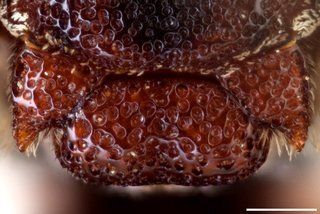
Thomas Onuferko · 9
Epeolus glabratus, Axillae mesoscutellum female |
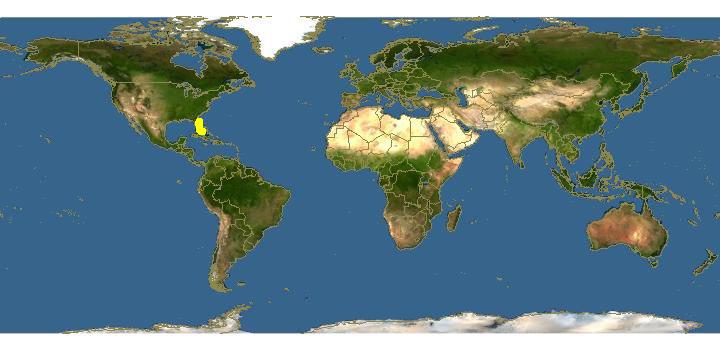
Click on map for details about points.
|
80x5 -
240x3 -
240x4 -
320x1 -
320x2 -
320x3 -
640x1 -
640x2
Set display option above.
Click on
images to enlarge. |
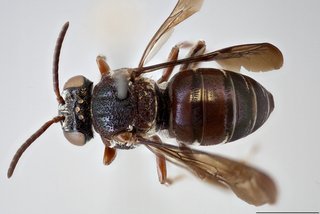
Thomas Onuferko · 9
Epeolus glabratus, Dorsal view female |
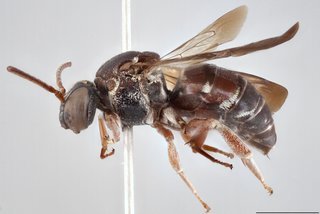
Thomas Onuferko · 9
Epeolus glabratus, Lateral view female |
|
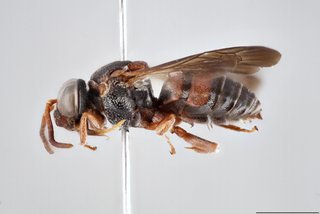
Thomas Onuferko · 9
Epeolus glabratus, Lateral view male |
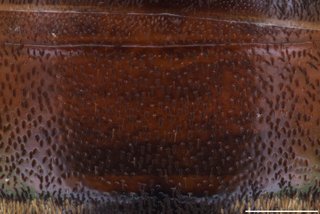
Thomas Onuferko · 9
Epeolus glabratus, T female |
|
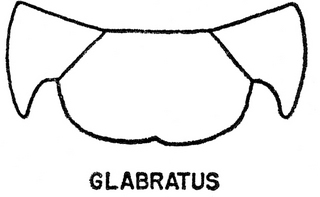
© Rebekah Andrus Nelson
· 1
Epeolus glabratus, both, top of thorax |
|
Overview |
Reprinted with permission from: Mitchell, T.B. 1962 Bees of the Eastern United States. North Carolina Agricultural Experiment Station Technical Bulletin No. 152.
FEMALE�Length 8 mm.; black, antennae and legs testaceous, labrum, mandibles, pronotum, tubercles, tegulae, scutellum, axillae, and discs of abdominal terga 1 and 2 more ferruginous; lateral ocelli separated from margin of vertex by about their own diameter; cheeks very narrow, less than half with of eyes, hind margin subcarinate; median length of labrum subequal to breadth, with a pair of small, subapical denticles; inner margin of mandibles nearly straight, neither dentate nor angulate; posterior margin of scutellum slightly impressed medially (fig. 110) ; axillae acute, strongly divergent from sides of scutellum apically, lateral surface separated from dorsal surface by a distinct carina; wings with the usual three submarginal cells, strongly infuscated, veins piceous; pubescence in general very short and inconspicuous, subappressed, rather dense between antennae and eyes, and back of wing bases; thoracic sternum densely white tomentose; punctures coarse, deep and irregular over most of head and thorax, becoming very fine and close on face below antennae, well separated across upper part of face just below ocelli, rather fine and close on cheeks, fine and densely crowded on pronotum, coarse and well separated on pleura, but becoming somewhat more finely rugose just below wing bases; tegulae very finely and rather closely punctate; scutum with a pair of anterior, longitudinal, shallow grooves on each side of midline, the punctures between these somewhat finer than on each side where they are somewhat more widely or definitely separated, becoming quite close across posterior margin, those on scutellum somewhat coarser and very close; punctures on ferruginous discs of abdominal terga 1 and 2 deep, distinct and well separated but not sparse, the depressed apical margins blackened and very minutely and closely punctate, the punctures obscured by fine, dense and dark, appressed tomentum, punctures of the more apical terga finer and closer; pseudopygidium quite extensive, median length nearly equaling apical width.
MALE�This agrees with the female in most characters, but mandibles are slightly angulate on inner margin. The pygidium is rather broadly rounded, median length about equal to basal width, with a distinct marginal carina.
DISTRIBUTION�Georgia and Florida; March to July.
FLOWER RECORD�Vicia.
|
|
|
Identification | |
Extracted from: Onuferko TM (2018). A revision of the cleptoparasitic bee genus Epeolus Latreille for Nearctic species, north of Mexico (Hymenoptera, Apidae). ZooKeys 755: 1–185. https://doi.org/10.3897/zookeys.755.23939
Diagnosis. The following morphological features in combination (excluding any that
are specific to the opposite sex of the one being diagnosed) can be used to tell E.
glabratus apart from all other North American Epeolus except E. lectoides: the axilla
is elongate, extending well beyond the midlength of the mesoscutellum but not as
far back as its posterior margin, and the free portion is distinctly hooked; the mesopleuron has sparser punctures ventrolaterally (most i>1d) than in upper half, with the
interspaces shining; the metasomal terga have minute, shallow punctures; T2–T4 are
medially bare; and the pseudopygidial area of the female is distinctly campanulate with
the apex <2 × the medial length. Whereas in E. lectoides the pronotal collar is black, as
are sometimes the axilla and mesoscutellum, and the metasomal terga are black and
fasciate, in E. glabratus the pronotal collar, axilla, mesoscutellum, and discs of T1 and
T2 are ferruginous and the pale pubescence on the metasomal terga are commonly
reduced to discrete lateral patches.
Redescription. MALE: Length 8.4 mm; head length 1.8 mm; head width 2.5
mm; fore wing length 7.9 mm.
Integument coloration. Black in part, at least partially ferruginous on mandible,
labrum, clypeus, antenna, pronotal collar, pronotal lobe, tegula, axilla, mesoscutum,
mesoscutellum, mesopleuron, metapleuron, legs, T1, T2, pygidial plate, and metasomal sterna. Mandible with apex darker than rest of mandible; preapical tooth lighter
than mandibular apex (difficult to see in holotype because mandible closed; described
from non-type specimens). Antenna brown except scape, pedicel, and F1 extensively
orange. F2 with orange spot basally. Pronotal lobe and tegula pale ferruginous to amber. Wing membrane dusky subhyaline, slightly darker at apex. Legs more extensively
reddish orange than brown or black.
Pubescence. Face with tomentum densest around antennal socket. Tomentum
slightly sparser on clypeus; upper paraocular and frontal areas, and vertexal area mostly
exposed. Dorsum of mesosoma and metasoma with bands of off-white to pale yellow short appressed setae. Mesoscutum with paramedian band. Mesopleuron sparsely
hairy, but tomentum dense ventrally as well as between two sparsely hairy patches (one
beneath base of fore wing (hypoepimeral area), a larger circular patch occupying much
of ventrolateral half of mesopleuron). Metanotum with tomentum uninterrupted except for median bare patch in posterior half, uniformly off white. T1 with discal patch
quadrangular and very wide, the basal and apical fasciae only narrowly joined laterally.
T1 with basal and apical fasciae and T2–T4 with apical fasciae widely separated medially, the apical fasciae reduced to pairs of small patches somewhat broader laterally; T2
with fascia without anterolateral extensions of tomentum, although few sparsely scattered pale hairs present. Remaining metasomal terga mostly hidden in holotype, but T5 and T6 with complete or narrowly interrupted fasciae in non-type specimens. S4
and S5 with long coppery to silvery subapical hairs.
Surface sculpture. Punctures dense, but those of head and mesosoma sparser in
some areas, larger, deep, and distinct. Labrum with larger punctures than clypeus, but
punctures of both equally dense (i<1d). Small impunctate shiny spot lateral to lateral
ocellus. Mesoscutum, mesoscutellum, and axilla very coarsely and densely punctate;
the interspaces shining. Tegula densely punctate (i≤2d). Mesopleuron mostly with
denser (i≤1d) punctures in upper half than ventrolateral half (i>1d), the interspaces
shining. Metasomal terga with punctures very fine, dense (i≥1d), somewhat evenly
distributed on disc; the interspaces shining somewhat.
Structure. Preapical tooth blunt and obtuse. Labrum with pair of small subapical
denticles, each preceded by small discrete longitudinal ridge. Frontal keel not strongly
raised. Scape with greatest length 1.7 × greatest width. F2 noticeably longer than wide
(L/W ratio = 1.3). Preoccipital ridge not joining hypostomal carina, from which it is
separated by less than 1 MOD at its terminal (difficult to see in holotype; described
from non-type specimens). Mesoscutellum moderately bigibbous. Axilla large, its lateral margin (L) more than half as long as mesoscutellar width (W) (L/W ratio = 0.6)
and tip extending well beyond midlength of mesoscutellum but not as far back as its
posterior margin; axilla with tip conspicuously diverging from side of mesoscutellum,
distinctly hooked, and axilla with free portion 2/5 its medial length; axilla with lateral
margin relatively straight and with tip carinate. Fore wing with three submarginal
cells. Pygidial plate mostly hidden in holotype, but apically rounded, with large deep
punctures more or less evenly spaced throughout with the interspaces shining in nontype specimens.
FEMALE: Description as for male except for usual secondary sexual characters and
as follows: F2 even longer than wide (L/W ratio = 1.5); T5 with two large patches of
pale tomentum lateral to and separate from pseudopygidial area present only in female;
T5 with pseudopygidial area campanulate, its apex less than twice as wide as medial
length, indicated by silvery setae on impressed disc of apicomedial region elevated
from rest of tergum; S4 and S5 with much shorter hairs (S5 with apical fimbria of coppery to silvery hairs extending beyond apex of sternum by ~1/3 MOD); pygidial plate
apically truncate, with small, denser punctures.
|
|
|
Names | |
|
|
| Supported by | |
Updated: 2024-04-25 09:57:11 gmt
|